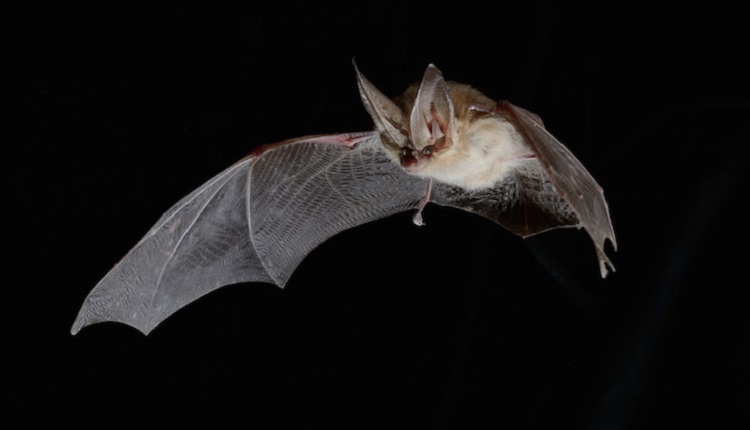Scientists crack the genetic code of how bats survive viruses
Posted 22 July, 2020

Scientists have discovered the genetic blueprints behind six of the world's bats, mapping their complete DNA for the first time.
The breakthrough offers fresh clues into the animals 'exceptional immunity', which protects them against cancer and other deadly diseases including the coronavirus.
Among the international team that carried out the research was (opens in a new window)Professor Emma Teeling, of UCD School of School of Biology and Environmental Science.
“Given these exquisite bat genomes, we can now better understand how bats tolerate viruses, slow down ageing, and have evolved flight and echolocation,” she said.
“These genomes are the tools needed to identify the genetic solutions evolved in bats that ultimately could be harnessed to alleviate human ageing and disease.”
Professor Teeling is the co-founding Director of (opens in a new window)Bat1K, a global consortium of scientists dedicated to sequencing the genomes of every one of the 1421 living bat species.
Six of those genomes are now complete, the consortium reports in (opens in a new window)Nature.
To analysed the genomes, the group sequence the bats’ DNA, and generated new methods to assemble these pieces into the correct order and to identify the genes present.
This week on the Nature cover: Secrets of the bat clade. Reference genomes of six species reveal origins of unique bat abilities. Browse the issue here: (opens in a new window)https://t.co/kXGhV9izgL (opens in a new window)pic.twitter.com/ZtWEPfiK09
— Nature (@nature) (opens in a new window)July 22, 2020
“Using the latest DNA sequencing technologies and new computing methods for such data, we have 96-99% of each bat genome in chromosome level reconstructions - an unprecedented quality akin to for example the current human genome reference which is the result of over a decade of intensive 'finishing' efforts,” said Professor Eugene Myers, Director of Max Planck Institute of Molecular Cell Biology and Genetics, and the Center for Systems Biology, Dresden.
"As such, these bat genomes provide a superb foundation for experimentation and evolutionary studies of bats’ fascinating abilities and physiological properties."
The team compared these bat genomes against 42 other mammals to address the unresolved question of where bats are located within the mammalian tree of life.
Using novel phylogenetic methods and comprehensive molecular data sets, the team found the strongest support for bats being most closely related to a group called Ferreuungulata that consists of carnivores (which includes dogs, cats and seals, among other species), pangolins, whales and ungulates (hooved mammals).
To uncover genomic changes that contribute to the unique adaptations found in bats, the team systematically searched for gene differences between bats and other mammals, identifying regions of the genome that have evolved differently in bats and the loss and gain of genes that may drive bats’ unique traits.
“Our genome scans revealed changes in hearing genes that may contribute to echolocation, which bats use to hunt and navigate in complete darkness. Furthermore, we found expansions of anti-viral genes, unique selection on immune genes, and loss of genes involved in inflammation in bats," Dr Michael Hiller, Max Planck Research Group Leader, Max Planck Institute of Molecular Cell Biology and Genetics in Dresden, Max Planck Institute for the Physics of Complex Systems, and the Center for Systems Biology, Dresden.
"These changes may contribute to bats’ exceptional immunity and points to their tolerance of coronaviruses."
The team also found evidence that bats’ ability to tolerate viruses is reflected in their genomes.
The genomes revealed “fossilised viruses”, evidence of surviving past viral infections, and showed that bat genomes contained a higher diversity than other species providing a genomic record of historical tolerance to viral infection.
Given the quality of the bat genomes the team uniquely identified and experimentally validated several non-coding regulatory regions that may govern bats’ key evolutionary innovations.
“Having such complete genomes allowed us to identify regulatory regions that control gene expression that are unique to bats. Importantly we were able to validate unique bat microRNAs in the lab to show their consequences for gene regulation," Dr Sonja Vernes, Co-Founding Director Bat 1K, Max Planck Institute for Psycholinguistics, Nijmegen.
"In the future we can use these genomes to understand how regulatory regions and epigenomics contributed to the extraordinary adaptations we see in bats."
The study was funded in part by the Max Planck Society, the European Research Council, the Irish Research Council, the Human Frontier Science Program, and the United States National Science Foundation.
By: Staff Writers, UCD University Relation






